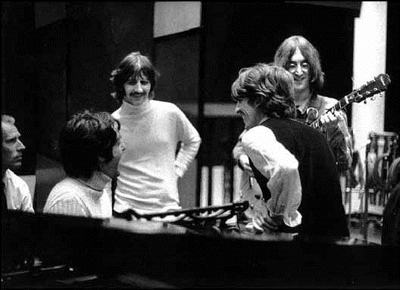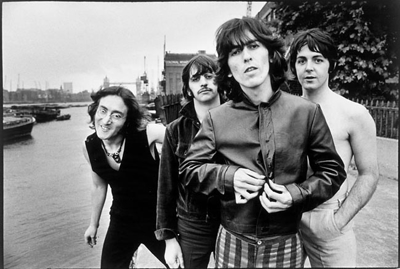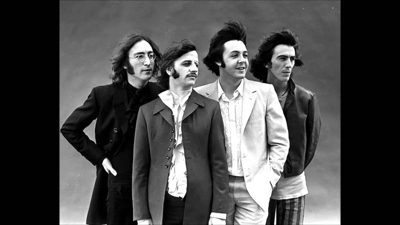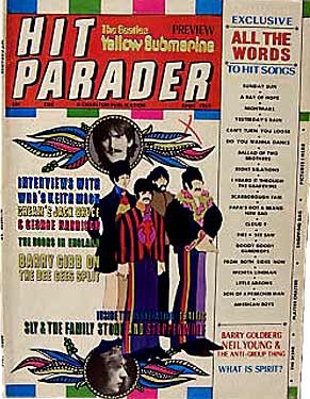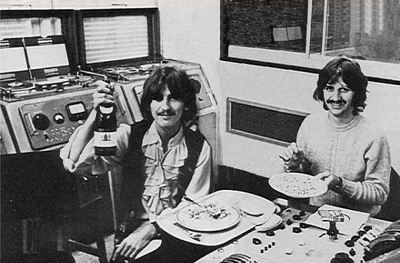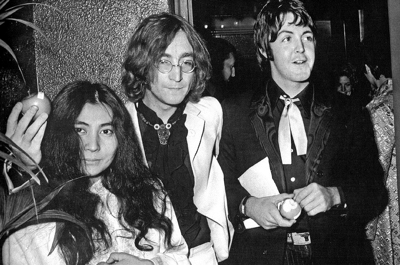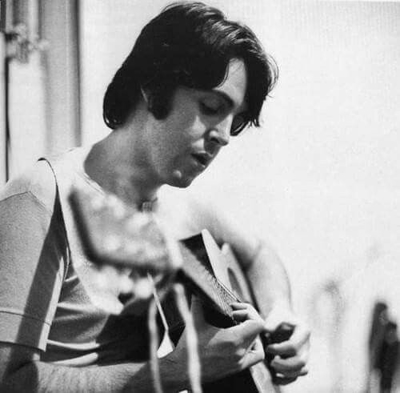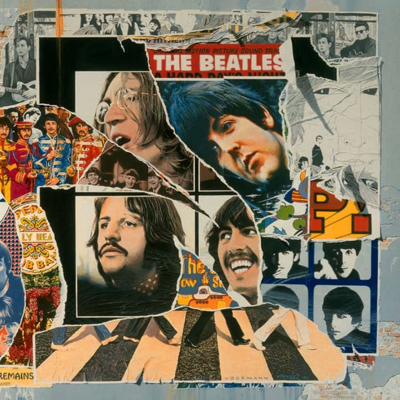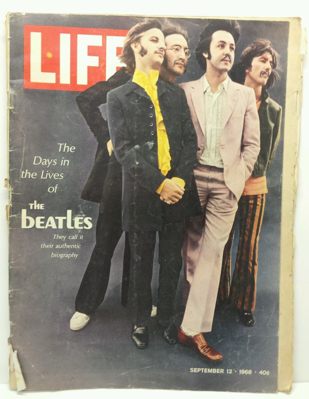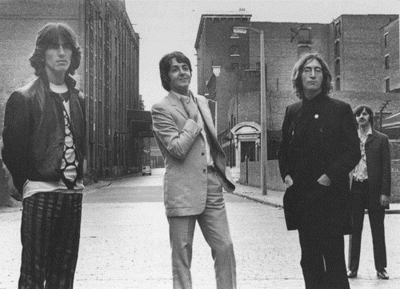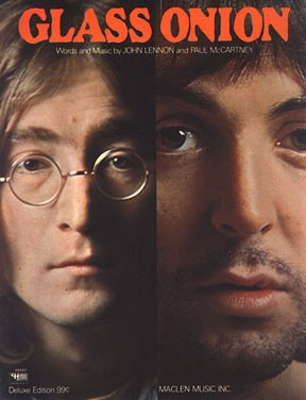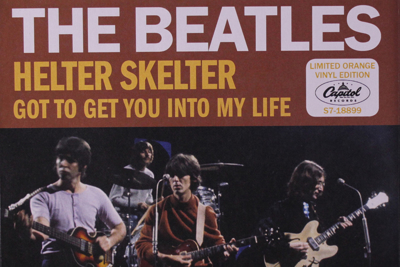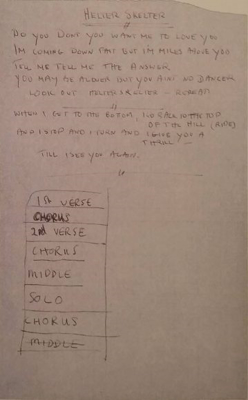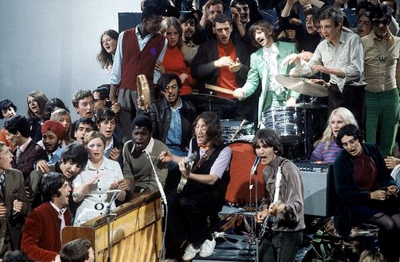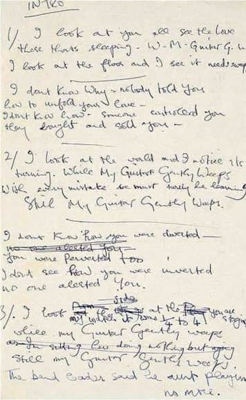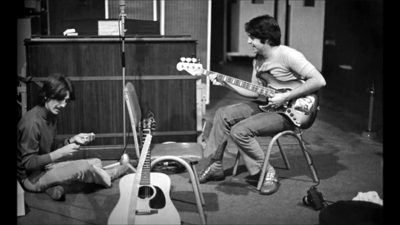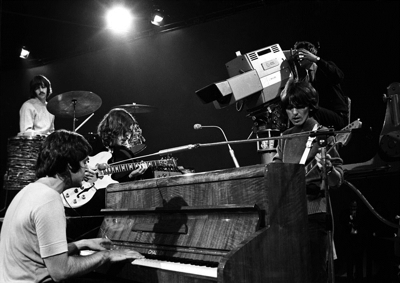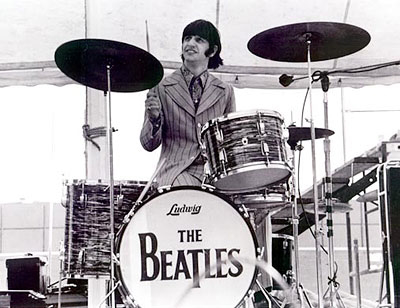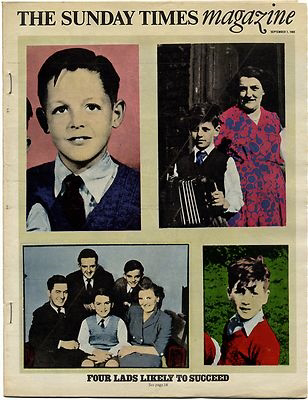1968, September
Hey Jude - The Beatles
The Beatles single "Hey Jude" hits the top of the charts, it is over seven minutes long and was the longest song ever to hit No. 1, a record it holds to this day.
Hey Jude - The Beatles
Mixing: Happiness Is A Warm Gun, What’s The New Mary Jane, Glass Onion, I Will
Thursday 26 September 1968 Studio
Studio Two (control room), EMI Studios, Abbey Road
Producer: Chris Thomas
Engineer: Ken Scott
This 7pm-1.30am session saw mono mixes created for three White Album songs, as well as one for the unreleased What's The New Mary Jane.
The first song to be tackled was Happiness Is A Warm Gun, the most recent to be recorded. Two mono mixes had been made the night before, and on this evening a further 10, numbered 3-12, were made.
What's The New Mary Jane had been recorded on 14 August 1968 by John Lennon, Yoko Ono and George Harrison. Although it was considered a contender for the White Album until shortly before its release, it remained in the EMI vaults until 1996's Anthology 3.
Two mono mixes of What's The New Mary Jane were made, followed by two apiece of Glass Onion and I Will.
Editing, recording, mixing: Happiness Is A Warm Gun
Wednesday 25 September 1968 Studio
Studio Two, EMI Studios, Abbey Road
Producer: Chris Thomas
Engineer: Ken Scott
Two separate sessions took place on this day, both of which saw work continue on the White Album song Happiness Is A Warm Gun.
The first session took place from 7.30pm-5am. The previous day The Beatles had decided that elements of both take 53 and take 65 of the rhythm track had been the best performances of Happiness Is A Warm Gun In Your Hand, as the song was then known.
The day's first task, therefore, was to an edit to be made of the two parts, directly onto the eight-track tape; this edit can be heard at 1'34" on the released versions.
The Beatles were then able to begin overdubs. These included lead and backing vocals, lead guitar by John Lennon, more bass guitar, organ, piano, hi-hat and tambourine. A tuba, reportedly played by Paul McCartney, was also recorded but left out of final mixes, as were the organ and piano overdubs.
With that the song was complete. A second session took place in the control room of Studio Two from 5-6am in the morning of 26 September 1968, and saw two mono mixes made. These were improved upon later that evening, and the final stereo mix was made on 15 October.
Recording: Happiness Is A Warm Gun
Tuesday 24 September 1968 Studio
Studio Two, EMI Studios, Abbey Road
Producer: Chris Thomas
Engineer: Ken Scott
The Beatles continued work on Happiness Is A Warm Gun during this 7pm-2am session. While recording the song, they used the working title Happiness Is A Warm Gun In Your Hand.
Forty-five takes of the rhythm track had been recorded in the first session. On this evening they taped another 25, numbered 46-70, with the same instruments as before: John Lennon playing electric guitar and singing a guide vocal, George Harrison on another electric guitar, Paul McCartney playing bass, and Ringo Starr on drums.
Eventually it was decided that take 53 was the best performance of the bulk of the song, but, from the singing of the title until the end, take 65 had been best. The two parts were edited together during the following session; the edit can be heard at 1'35" in the final recording.
Recording: Happiness Is A Warm Gun
Monday 23 September 1968 Studio
Studio Two, EMI Studios, Abbey Road
Producer: Chris Thomas
Engineer: Ken Scott
One of the White Album's highlights, Happiness Is A Warm Gun, had its first recording session on this evening.
The session took place from 7pm-3am. The Beatles recorded 45 takes of the song, which had the working title Happiness Is A Warm Gun In Your Hand. John Lennon played electric guitar and sang a guide vocal, George Harrison was on another electric guitar, Paul McCartney played bass, and Ringo Starr was on drums.
The song's various changes in tempo and time signature resulting in a number of breakdowns. The following evening they taped another 25 attempts, which eventually resulted in a usable backing track.
Hey Jude - The Beatles
George Harrison spoke with Alan Smith for an exclusive interview that would be published in the September 21st 1968 issue of The New Musical Express. The article, entitled 'George Harrison is a Rocker Again!' would later be reprinted for the United States in the April 1969 issue of Hit Parader.
In this interview, Harrison discusses recording, songwriting, his preferences on the possiblity of the Beatles performing live again, and in passing even seriously mentions the potential for a Beatles/Elvis collaboration album.
Former Beatles' press officer Tony Barrow also has an article in the same issue of the New Musical Express entitled, 'Seeds Which Grew Into an Apple' which features a Beatles history outline.
At the time of this September 1968 interview, 'Hey Jude' is the number one single in the United States, Britain, and pretty much everywhere else across the entire planet. The White Album would be released just two months later at the end of November.
- Jay Spangler, www.beatlesinterviews.org
"Richard. Little Richard. That's who I'd love to record. He's a fantastic character with a fantastic voice - and whether he's singing rock or gospel, he's still great."
George Harrison unconsciously tapped his soft shoe in rhythm as he talked and we both jumped at the deep end of nostalgia as we chatted about the good old days when Elvis was King and Richard used to tuttifruit his head off.
Extending his 'I'm a Rocker Again' thesis and continuing his comments reported recently George said he didn't care to dwell on the 'Mystical Beatle George' anymore.
"It's still all 'Within You, Without You,'" he added, "but I don't want to go into that any more 'cuz now I'm being a rock and roll star."
The crooked grin broke into a crooked smile.
"I'm still writing, though, and after 'Sour Milk Sea,' I've got a few songs I've done on the next Beatles' LP. At least, I think they'll be on it. We haven't worked it all out yet.
"I've got a lot of songs kicking about in the air, and there's also about two or three I've got at home. But I don't know whether to do 'em or not.
"Sometimes I write them and with the mood I'm in, they're OK. But I come back to 'em later and I'm not in that mood anymore. So I think, 'Oh, well... Rubbish!'
"I've been doing that for years.
"Come to think of it, I've probably thrown away at least 20 good songs which, had I followed them through, would have been at least as good as all the other ones.
"Sometimes I put on a tape at home, and I find there are five bits of songs I wrote around 1954-five-six-or-seven, that I just forgot completely about.
"I've got a song I liked when I first wrote it, and I still like it, but in between I thought, 'Aw, this is a bit too much. People are not gonna believe this.'
"Anyway, I took it out recently, looked at it, and I know they're still not going to get it. The reason is it still tends to have that deep meaning thing -- and I'm trying to get out of that.
"I now want to write songs that don't have any meaning, because I'm a bit fed up with people coming up and saying, 'Hey, what's it all about? What does it mean?'"
I asked George if he got any really creative experience out of writing and recording.
He said, "Of course -- it's all like a challenge. You get the idea and you've got the bit of plastic to put it on but then there's the actual thing of going through all that bit of getting musicians together and making people do things the way you want, trying to get the best out of it.
"And then, in the end, when you've done all that, you've got a little thing there, like a painting. And you put it out, and people say, 'Oh, it's a load of ...... man.'
"But it doesn't matter. Not to me anyway, because you get a lot of people who do like it, and it is worth while."
We got onto the Beatle fan's biggest hope of all -- Will the Beatles ever play live again?
Answer from George, with that smile again, "It just depends. The thing I'd like to do most of all is play resident in a club. Not to go touring... because I didn't like all that traveling and playing, and all that sort of thing.
"But if we were to do a live show, I'd prefer to do it like at the Top Ten in Hamburg for three months, and just play in the one place for about three months. Then we could get rid of the myth once and for all of the Beatles being something apart from everybody else.
"Obviously, we go through cycles. At the moment, it's all that bit like getting my guitar out again, and it's happened quite a bit on this next album of the Beatles.
"We've got 'together' for it. Like, in the early days we were pretty good because we played for so long in one place. That's why I'd like to do a resident spot. Then you've got your amps and your drums set up, and get used to the one sound.
"All these people come to see you, too, so you can't hide. You can't fake anything. It's like, you know, you've got your trousers down. And there's nothing to hide.
"Now, we're trying to get as funky as we were in the Cavern. 'Cuz in the Cavern and Hamburg, all we really were was thump-thump-thump. But so together, you know, because we were playing all the time. And those were the days when we used to think that 'Twist and Shout' was too way-out for a single. All very 'Shadows' it was, then, and getting into suits.
The next album is much simpler than 'Pepper' because it's more down to guitars, bass and drums, and maybe a piano. There's a nice one of Paul just playing with his guitar, singing by himself but with just a bit of brass on it."
We got on to the subject of the King, and George said, "I remember at school there was all that thing about Elvis. You never really wanted to go to school, you wanted to go out and play or something. So when some record came along like Elvis' 'Heartbreak Hotel,' and you had this little bit of plastic... it was so amazing. Now, it's hard to realize that there are kids like I was, where the only thing in their life is to get home and play their favorite record, and maybe it's ours.
"We know Elvis is great. We know he is. He stopped being a rocker, and they made him go into the Army and by the time he came out he was a clean healthy American doing clean healthy songs and films. But basically, he's got such a great bluesy voice.
"It would be great if the Beatles and Elvis could get together for an album. It really would."
The Beatles are inbetween recording today.
Recording: Piggies
Thursday 19 September 1968 Studio
Studios One and Two, EMI Studios, Abbey Road
Producer: Chris Thomas
Engineer: Ken Scott
Work began on Piggies during this session. It was the third George Harrison song to be recorded for the White Album.
The session began in Studio Two at Abbey Road, but switched when producer Chris Thomas discovered a harpsichord in Studio One and suggested that The Beatles take advantage of it.
All four Beatles were there for the session and we were working in [studio] number two. I wandered into number one and found a harpsichord, not knowing that it had been set up overnight for a classical recording. So we discussed wheeling the thing into number two but Ken Scott said `No, we can't, it's there for another session!'. So we moved our session into number one instead.
George Harrison agreed that my harpsichord idea was a good one and suggested that I play it. This I did, but while George and I were tinkling away on this harpsichord he started playing another new song to me, which later turned out to be Something. I said 'That's great! Why don't we do that one instead?' and he replied 'Do you like it, do you really think it's good?'. When I said yes he said 'Oh, maybe I'll give it to Jackie Lomax then, he can do it as a single!'- (Chris Thomas -The Complete Beatles Recording Sessions, Mark Lewisohn)
The Beatles recorded 11 takes of Piggies, with Thomas on harpsichord, Harrison on acoustic guitar, Paul McCartney playing bass guitar and Ringo Starr on tambourine. John Lennon was present at the session but didn't play.
The session ended at 5.30am on the morning of 20 September 1968. Overdubs of lead vocals and pig noises were added later that evening, and Piggies was completed on 10 October when a string octet was recorded.
Recording, mixing: Birthday
Wednesday 18 September 1968 Studio
Studio Two, EMI Studios, Abbey Road
Producer: Chris Thomas
Engineer: Ken Scott
While the sessions for the White Album often found The Beatles labouring for days on individual songs, at other times they worked quickly. One example of this was Birthday, written and recorded on this day.
Paul McCartney arrived earlier to the studio than the other Beatles, and began playing around with the song's guitar riff. As the rest of the group arrived they began jamming, and the song developed into Birthday.
We thought, 'Why not make something up?' So we got a riff going and arranged it around this riff. We said, 'We'll go to there for a few bars, then we'll do this for a few bars.' We added some lyrics, then we got the friends who were there to join in on the chorus. So that is 50-50 John and me, made up on the spot and recorded all on the same evening. I don't recall it being anybody's birthday in particular but it might have been, but the other reason for doing it is that, if you have a song that refers to Christmas or a birthday, it adds to the life of the song, if it's a good song, because people will pull it out on birthday shows, so I think there was a little bit of that at the back of our minds. (Paul McCartney -Many Years From Now, Barry Miles)
The Beatles recorded 20 takes of the song, after which they decamped to McCartney's house to watch the 1956 film The Girl Can't Help It. This was the first UK television screening of the rock 'n' roll classic, starring Jayne Mansfield and featuring guest appearances from Little Richard, Eddie Cochran and Gene Vincent, and was shown on BBC 2 from 9.05-10.40pm.
Take 19 of Birthday was chosen as the best version, and the four-track tape was copied onto an eight-track machine – the copies were numbered takes 21 and 22. Meanwhile, McCartney and John Lennon wrote the lyrics, which they then overdubbed.
Guests at the session were Yoko Ono and Pattie Harrison, who joined in with backing vocals and handclaps. The recording was completed with tambourine and piano, the latter fed through a Vox amplifier and treated with distortion.
At around 4.30am Birthday was mixed in mono. John Lennon used the studio control room microphone to announce: "This is Ken MacIntosh and the roving remixers. Take farty-one".
Recording, mixing: Helter Skelter, I Will
Tuesday 17 September 1968 Studio
Studio Two, EMI Studios, Abbey Road
Producer: Chris Thomas
Engineer: Ken Scott
The Beatles completed the recording of I Will during this session, and created the mono mix of Helter Skelter.
The mono mix for Helter Skelter followed its recording on 9 and 10 September 1968. This truncated most of the final minute, including Ringo Starr's famous cry "I've got blisters on my fingers!" – unlike the stereo mix, which was made on 12 October 1968.
It is likely that Paul McCartney was the only Beatle in the studio on this evening. He added harmony vocals, another acoustic guitar track, maracas, and a vocal bass line onto I Will.
Before the session ended at 5am, the four-track tape of Cry Baby Cry, which had last been added to on 18 July, was copied to eight-track tape for further overdubs. However, nothing else was added to the recording prior to its release on the White Album.
Recording: I Will, Glass Onion
Monday 16 September 1968 Studio
Studio Two, EMI Studios, Abbey Road
Producer: Chris Thomas
Engineer: Ken Scott
The Beatles began recording the White Album ballad I Will during this session.
George Harrison was absent, so it was a three-man effort. Paul McCartney sang and played acoustic guitar, Ringo Starr played drums and maracas, and John Lennon kept a beat on temple blocks.
It took 67 attempts before a satisfactory take was completed. McCartney also led the others through various improvisations, including take 19, better known as Can You Take Me Back?, which appeared on the White Album in between Cry Baby Cry and Revolution 9.
Also during the session, the trio recorded Step Inside Love, a song written by McCartney for Cilla Black. Their rendition segued into an improvised song, Los Paranoias. These were included on 1996's Anthology 3, along with take one of I Will.
Take 65 was chosen of the best take of I Will. The Beatles had been recording the session on four-track tape, and to enable further overdubs the performance was dubbed onto eight-track tape.
At the end of the session a brief overdub was added to Glass Onion: the sound of a recorder, played by Paul McCartney, after the couplet about The Fool On The Hill.
In UK Hey Jude by The Beatles was in the top 5 hits.
In UK Hey Jude by The Beatles was in the top 5 hits.
Recording: Glass Onion
Studio Two, EMI Studios, Abbey Road
Producer: Chris Thomas
Engineer: Ken Scott
The third recording session for Glass Onion saw further overdubs onto the rhythm track, which had been taped on 11 September 1968.
Piano and further drums were taped during this session, which began at 8pm and ended at 1.45am.
Paul McCartney recorded a brief recorder part three days later, and on 10 October Glass Onion was completed with string overdubs.
Life Magazine, September 13, 1968 - The Beatles
Recording: Glass Onion
Studio Two, EMI Studios, Abbey Road
Producer: Chris Thomas
Engineer: Ken Scott
Having recorded the rhythm track for Glass Onion during the previous day's session, The Beatles began overdubbing onto the penultimate attempt, take 33.
Tambourine and a lead vocal were the first to be recorded. Afterwards John Lennon manually double tracked his vocals in places.
The session was a relatively brief one, by The Beatles' 1968 standards, lasting from 8.30pm-1.30am.
In the UK Hey Jude by The Beatles was in the top 5 hits.
Recording: Glass Onion
Wednesday 11 September 1968 Studio
Studio Two, EMI Studios, Abbey Road
Producer: Chris Thomas
Engineer: Ken Scott
The Beatles began the recording of Glass Onion, the third song on the White Album, during this 7pm-3.30am session.
Thirty-four takes of the rhythm track were recorded, with John Lennon on acoustic guitar, George Harrison on electric guitar, Paul McCartney playing bass, and Ringo Starr on drums.
Each take was roughly the same length, apart from take 15 which became a six-minute jam. The group's penultimate attempt, take 33, was considered the best, and overdubs began the following day.
Recording: Helter Skelter
Recording: Helter Skelter
Tuesday 10 September 1968 Studio
Studio Two, EMI Studios, Abbey Road
Producer: Chris Thomas
Engineer: Ken Scott
Having recorded the backing track of Helter Skelter on the previous night, the song was completed during this 7pm-3am session with a number of further overdubs.
This was evidently a wild session, as chaotic in the studio as it sounded on record. The overdubs included lead and backing vocals, lead guitar (George Harrison), piano (heard at the end of the stereo mix), and a second drum track. Also recorded were amateurish saxophone and trumpet, played by John Lennon and Mal Evans respectively.
While Paul McCartney was recording his lead vocals, Harrison ran around the studio with a flaming ashtray above his head. This likely prompted McCartney's spoken aside – audible on the multitracks but barely decipherable on the finished mixes – in a heavy northern accent: "Are you comin', son? I saw you do that, you little bugger. Pop yer bloody hands on yer 'ead, come on!" It occurs just after the three-minute mark.
While Paul was doing his vocal, George Harrison had set fire to an ashtray and was running around the studio with it above his head, doing an Arthur Brown! All in all, a pretty undisciplined session, you could say!
Chris Thomas
The Complete Beatles Recording Sessions, Mark Lewisohn
Helter Skelter was given a mono mix on 17 September 1968, and stereo mixes were made on 12 October. The long gap between the two dates probably accounts for the disparities between the two versions; the mono mix omits almost a minute of the ending, including Ringo Starr's famous shout "I've got blisters on my fingers!"
Recording: Helter Skelter
Monday 9 September 1968 Studio
Studio Two, EMI Studios, Abbey Road
Producer: Chris Thomas
Engineer: Ken Scott
The Beatles had recorded three lengthy rehearsal takes of Helter Skelter on 18 July 1968. During this 7pm-2.30am session, however, the song was transformed from a slow blues jam into the frantic cacophony heard on the White Album.
This was also the first session in which George Martin's assistant Chris Thomas had a formal production role, although he had been present at a number of earlier Beatles recordings.
The group recorded 18 takes of Helter Skelter, numbered 4-21, on this night. The last of these provided the basis for the album version. Paul McCartney played the opening guitar riff and further rhythm guitar, while John Lennon was on bass guitar and Ringo Starr played a blistering drum part.
The version on the album was out of control. They were completely out of their heads that night. But, as usual, a blind eye was turned to what the Beatles did in the studio. Everyone knew what substances they were taking but they were really a law unto themselves in the studio. As long as they didn't do anything too outrageous things were tolerated.
Brian Gibson, technical engineer
The Complete Beatles Recording Sessions, Mark Lewisohn
Helter Skelter was given further overdubs on the following evening. These included lead and backing vocals, lead guitar, piano, more drums, trumpet and saxophone.
Beatles Timeline: 1968: Hey jude (sept 8)
In UK Hey Jude by The Beatles was in the top 5 hits.
Recording: While My Guitar Gently Weeps
This was the session in which Eric Clapton recorded his famous guitar solo onto While My Guitar Gently Weeps.
George Harrison had invited Clapton to the session earlier that day, while giving him a lift from Surrey to London. Despite Clapton's initial wariness about performing on a Beatles song, Harrison insisted that it would be fine.
Clapton used the Gibson Les Paul guitar that Harrison had given him a month previously. His presence in the studio reportedly made the other Beatles more attentive and enthusiastic about the song, doubtless to Harrison's relief.
The solo replaced an earlier guitar track performed by John Lennon on the previous day. Harrison overdubbed organ and two lead vocals, Paul McCartney added vocal harmonies and a distorted bass guitar part, and Ringo Starr played tambourine and castanets.
Mono and stereo mixes were made on 7 October, but these were improved upon on 14 October.
Recording: While My Guitar Gently Weeps
Two separate versions of While My Guitar Gently Weeps were worked on during this session: overdubs to the first group attempt, and a remake which eventually became the released version.
The song's composer George Harrison recorded two separate lead vocal tracks, and with the other Beatles overdubbed maracas, drums and lead guitar. However, after hearing a playback of the progress so far, Harrison decided to scrap the recording and start afresh.
The Beatles recorded 28 takes of a new rhythm track during this session, filling three reels of eight-track tape. These takes were numbered 17-44. Take 25 was eventually decided as the best, and featured Harrison's guide vocals and acoustic guitar, John Lennon on electric guitar, Paul McCartney on piano, and Ringo Starr playing drums.
McCartney played organ on some of the unused takes, and also busked a version of Lady Madonna after take 40.
Take 25 received further overdubs and was completed on the following day, including Eric Clapton's famous guitar solo.
Filming: Hey Jude, Revolution
On this day The Beatles filmed promotional films for Hey Jude and Revolution at Twickenham Film Studios.
They arrived at the studios at 1.30pm and worked until evening. The set, at the studio's stage one, had been assembled over the previous three days. Only The Beatles' lead and backing vocals were recorded live, although instruments and amplifiers were set up. The Musicians' Union had placed a ban on miming, and the live vocals were an attempt to hide this.
The completed films – two for each song, both in colour – were directed by Michael Lindsay-Hogg, whom had worked with The Beatles on the clips for Paperback Writer and Rain in 1966. Hey Jude was the first to be made, and featured Paul McCartney seated at an upright piano, John Lennon and George Harrison on a nearby podium with guitars, and Ringo Starr positioned on a drum riser behind them.
A 36-piece orchestra was also assembled, the members wearing white tuxedos, and 300 extras were brought in for the finale. The latter had been recruited after 20 students handed out leaflets in the area, and The Beatles' assistant Mal Evans invited a number of fans from outside EMI Studios.
At least three takes of Hey Jude were filmed, and the most commonly-seen promo was an edit of takes one and three. In each of them McCartney sang along to the studio vocals, and ad-libbed live during the extended ending.
The Hey Jude film had its world premiere on 8 September 1968 on Frost On Saturday, presented by David Frost. To make it seem as though The Beatles were on the programme, David Frost visited Twickenham on this day to record an introduction.
We made a film in front of an audience. They had brought people in for Hey Jude. it wasn't done just for David Frost, but it was shown on his show and he was actually there when we filmed it. (George Harrison-Anthology)
The group also performed the David Frost show's theme tune, written by George Martin and titled By George! It's The David Frost Theme. Afterwards Frost appeared on camera to introduce the Hey Jude performance.
Beautiful. Absolute poetry. Welcome back to part three, as you can see, with the greatest tea-room orchestra in the world. Right? Beautiful, beautiful. Absolutely, beautiful. As you can see, making their first audience appearance for over a year, ladies and gentlemen, The Beatles! (David Frost)
At that point The Beatles broke into an impromptu rendition of Elvis Presley's It's Now Or Never, although this was edited out of the broadcast.
For the Revolution clips The Beatles overdubbed a new vocal track onto the studio version. Paul McCartney performed the scream during the introduction, and the 'shoo-be doo-wop' backing vocals from the slower, then-unreleased Revolution 1 were sung.
The only contemporary UK screening of the Revolution clip was on the BBC's Top Of The Pops on Thursday 19 September.
Ringo Starr rejoins The Beatles
I had definitely left, I couldn't take it any more. There was no magic and the relationships were terrible. I'd come to a bad spot in life. It could have been paranoia, but I just didn't feel good – I felt like an outsider. But then I realised that we were all feeling like outsiders, and it just needed me to go around knocking to bring it to a head.
I got a telegram saying, 'You're the best rock'n'roll drummer in the world. Come on home, we love you.' And so I came back. We all needed that little shake-up. When I got back to the studio I found George had had it decked out with flowers – there were flowers everywhere. I felt good about myself again, we'd got through that little crisis and it was great. And then the 'White' album really took off – we all left the studio and went to a little room so there was no separation and lots of group activity going down.
Ringo Starr
Anthology
At George Harrison's instigation, Mal Evans covered Ringo's drum kit with dozens of flowers.
Although Ringo's return from Sardinia was much celebrated, there was little for him to do in this recording session, which took place in Abbey Road's studio two from 7pm until 3.30am the following morning. George Harrison worked alone, recording a backwards guitar solo for While My Guitar Gently Weeps.
In UK Hey Jude by The Beatles was in the top 5 hits.
In UK Hey Jude by The Beatles was in the top 5 hits.
Also, the Sunday Times Edition
- 1970
- 1969
- 1968
- 1967
- 1966
- 1965
- 1964
- 1963
- 1962


